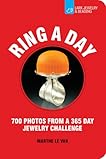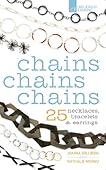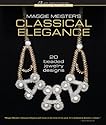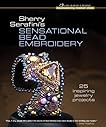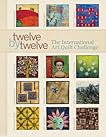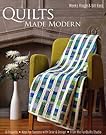 Quilts Made Modern: 10 Projects, Keys for Success with Color & Design, From the FunQuilts Studio by Weeks Ringle
Quilts Made Modern: 10 Projects, Keys for Success with Color & Design, From the FunQuilts Studio by Weeks Ringle
In general, I like this book. I like it because the tone is kind. I like it a lot more than most project books because the authors weave additional information beyond how to make the included projects their way into the text.
Quilt books seem to be going the way of projects rather than inspiration or catalog books. If that is the wave of the future, then I hope authors and publishers take a page from this work and from books books like 12×12. This book has a lot of very personal aspects. The book starts out with some good advice and a reminder. Weeks Ringle reminds us “how healing a creative hobby can be when dealing with the potholes on the road of life.” Yes, it is project book (perhaps it is time to get over myself about that and just accept the fact that publishers aren’t going to branch out very often with books like 12×12), but Kerr and Ringle took the time to make this more than just a few projects. The book is infused with advice on color. The authors took the time to show and talk about a few color variations for each project. No, they didn’t make all of the quilts, but used line drawings. However, this is not a “my way or the highway” design team. They want the reader to be able to envision their quilts in different colors.
I really enjoyed the two other books, The Quiltmaker’s Color Workshop and The Modern Quilt Workshop by Bill Kerr and Weeks Ringle. I like their work and their writing attitude.
In one of their other books Bill Kerr and Weeks Ringle introduced their concept of “The Big Idea,” which they describe as “an idea, a memory, or a metaphor that serves as the inspiration for your quilt.” They remind us of that. It is the basic piece of their method. I like that they continue to use the same idea in another book. It makes me think it is not a gimmick.
Part of this concept is that the Big Idea is about design. Part of the design process is not to rush it which means that we always need to have something to sew on (e.g. a box of squares to sew together) so you don’t feel like you have to rush through the design process. I like this advice. It is a good reminder
Early in the book, the authors have a section on color theory. The authors use the Johannes Itten Color Star to show what a color wheel does and how it can be used. The Color Star theory is a very sophisticated way of using a color wheel. The Color Stars are really expensive now, but worth buying if you see a deal. They have very good gradations which means you can see the variations in hue, value and saturation very well. They do not fit in with Joen Wolfrom’s Color Play’s theories of color, but one or the other will get you where you need to go. Aside from the “which color wheel do I use theory, Quilts Made Modern color section has definitions of basic words used in color theory. The section includes basic examples of terms such as hue, value and saturation.
Throughout the book, the authors include sidebars and tip boxes in grey, which give more than tips. In the color section, there is a sidebar called “climbing out of a palette rut.” Just the title tells me this is a topic to which I may want to pay attention for my own work: don’t use the same colors all the time. They also ,remind readers that quiltmakers don’t have to wear the fabric, which is very important in terms of color selection. Since a quiltmaker will not be judged on his/her bright orange shirt, orange fabric can be considered to be a viable option for use in a quilt.
Color isn’t the only aspect of design to which we need to pay attention. Scale, figure/ground (also called negative space), proportion and a concept called “engaging the edge” are also addressed. Because many quilt fabrics have pattern, I appreciated that Bill and Weeks included information about scale in their design principles. Color proportion is also covered. This is a concept that quiltmakers don’t see addressed in quilt books very often. Color proportion is the concept of how much of one color to use in relation to the other colors.
Color is included in the design section, which is very long and detailed. I am pretty excited that Ringle and Kerr spent so much time on design and the publisher allowed it. In this section, readers are reminded of all that comprises the design process: color and forms of piecing, color and pattern of quilting along with the texture of the quilting. “Realizing that quilting is an important layer of design will help you be more intentional about the way you quilt your quilt” (pg.21). How often do you think of all of these elements as part of the design process? Me? Never. The section is a good reminder.
The authors also talk about the “More is Better Club” in this section where they remind us that “the trick is figuring out where the line is between lush and overdone.” This leads into their section on developing a palette. Also part of the design section is developing a palette. Kerr and Ringle give an example of a poor palette choice in addition to the other information. It is nice to have authors talk about their learning opportunities.
Another element of this book is a section about understanding fabric. Weeks and Bill talk about how fabric is made, which then leads to a discussion of different types of fabric. This section also includes a discussion of fabric printing technology. The authors have good suggestions for using large scale prints as well. They say “if the motif is on a solid field, then you’ll want to make sure that the pieces you’ll be using are big enough to accommodate the scale of the motif. Collaged motifs, even if they are in big repeats, are easier to use, because the motifs fill the pieces no matter how small.” The section also covers hand-dyes and batiks.
Auditioning fabrics, editing choices, using a design wall and paying attention to the effects of white are all elements of quilt design covered in this section.
By a third of the way through the book, the authors begin talking about design meeting construction. I love the imagery of design meeting construction! You can design whatever you want, but putting it together is a whole different issue. Borders are the first topic addressed and the authors bring up the point that “if a border is not thoughtfully integrated into the design, however, the proportions of the quilt can become visually awkward.”
There is a section of text that discusses pieced backs, which I haven’t seen in a book in this amount of detail. The section runs a few pages and suggests that the quiltmaker can “use up scraps from the front of the quilt” and “add playfulness to the quilt’s overall feel.” (pg.38)
Quilting thread has a prominent role in this book as well – colors, what it adds, changing colors mid-stream, how it works with batting – many aspects that, again, I have not seen covered in books I have read.
Bill Kerr and Weeks Ringle also give a few quilting options, in terms of designs, before they get to the quilt patterns.
The project patterns are well laid out with a clear list of materials for a variety of sizes as well as a *description* of the skill level rather than a number of spools or scissors. This type of description is much more useful than other types of skill indicators. The patterns don’t stop there, though. They weave in color throughout the patterns. Alternate colorways are shown, fabrics not selected for the project are shown and some other mini lessons pertaining to that particular quilt.
For the first quilt, Fashion District, the authors provide an auxiliary design lesson. Their special pearl of wisdom in this case is to point out that “not one of them (talking about fabric) has any white that would read as a hole in the quilt.” (pg. 51)
I find the alternate color ways to be important. They are not pictures of quilts, but computer generated layouts. Still, the reader gets a great idea of how the quilt would look with different fabrics.
In the pattern pages for Loft, they show what the quilt looks like in different sizes (pg.59). Again, the images are computer generated, but the reader gets an idea of the graphicality based on the repeats.
Most of the designs have a bold graphic appeal. While many of the patterns, when broken down into pieceable elements, are simple, the design aspect of many of the patterns making them look more complex.
A nine patch becomes a lesson in transparency (pg.63). A series of carefully pieced rectangles shows how simple elements can look complex (Improv, pg.93). The book also weaves in different techniques for making quilts without giving a dogmatic, my-way-or-the-highway impression of the book. In the Big Dots pattern they talk about using freezer paper to make the circles. They make a brief suggestion about machine applique’, but the preparation also lends itself to hand applique’.
Some of the elements of quiltmaking, which are often difficult to verbalize in books, are mentioned here and there in passing throughout Quilts Made Modern. For the Small Change pattern description (pg.109), Ringle and Kerr talk some about the value derived from a quilt that gets worked on constantly. They say “when you work on a something so long, you gain the added bonus of the many fond memories created during the hours spent quilting.” I find this to be true with my own quilts. I remember DH helping me with the math for the setting of my first sampler and he wasn’t even my DH then!. I remember working with TFQ on the Katrina quilt. I remember laying out all the pieces for the Sweet Harmony bag, taking up a good portion of the hallway, during the week I spent at TFQ’s, what we ate, the fabric stores we visited. I think this is one of the unsung joys of quiltmaking.
Another reason I like this book is that it is not all about one technique. They mix it up: machine piecing with hand quilting, hand applique’, machine piecing and machine quilting. The authors show that you don’t have to do only one technique and they guide their readers through the basics of the techniques included.
There is an obligatory section on how to make a quilt. I won’t go into my usual rant because it would just be a boring repeat. This section not just copied and pasted into the last 30 pages of the manuscript: the authors include their own reasons behind the practices they teach in the book. They suggest that you do not cut 8 layers of fabric at once regardless of how sharp your rotary cutter is. There is a reminder to close your blade guard, which I appreciate, as well as sections on pinning, and a small essay on hand and machine piecing.
In the section on preparing the quilt for quilting, Weeks and Bill suggest measuring “the quilt on both diagonals to ensure that the quilt is square ( the diagonals should measure exactly the same.” (pg.132). This is something I haven’t heard before and should try. I am a little scared to find out how un-square my quilts are! The techniques needed to make all the quilts in the book are covered. They are not covered in excruciating detail, but they are covered to the point where you can make the quilt. I would have liked to have an index so I could find things I wanted to look up. Throughout the book there is the sense that there are many different ways to do things and that it is important to find the method that works best for you.
View all my reviews
 Quick Quilts from Your Scrap Bag by Patricia Wilens
Quick Quilts from Your Scrap Bag by Patricia Wilens



